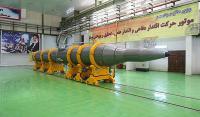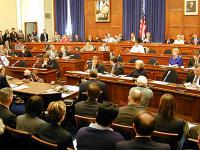-
U.S. to impose new sanctions on Iran over ballistic missile program

The United States is preparing a new round of economic sanctions against Iran after Iran had violated agreements related to its ballistic missile program by testing, on 10 October, an advanced version of one of its missiles. The ballistic missile agreement is unrelated to the nuclear agreement the P5+1 powers signed with Iran last summer. The nuclear program-related sanctions would begin to be lifted in 2016 if Iran fully complies with the requirements of the nuclear deal.
-
-
Iran began dismantling its nuclear program, but has way to go to come into full compliance: IAEA

The IAEA says that Iran has begun dismantling parts of its nuclear program, as agreed in a deal with the P5+1 powers – but that it has some way to go before coming into full compliance with the agreement. Iran has removed 4,500 centrifuges from the Natanz and Fordo site – but it has to remove 10,000 more before 15 December. Iran has added 460 kg low-enriched uranium to its stock – it now has 8.3 tons of low-enriched uranium – but that stock must be slashed to just 300kg by 15 December. If Iran does not meet in full these, and other, clauses in the agreement by 15 December, the economic sanctions will not be lifted.
-
-
Can Iran’s rulers still use enemies abroad to rally nation?

The rulers of the Islamic Republic of Iran have routinely used external conflicts to divert public attention from domestic problems, deflect attacks, promote national cohesion, and repress their opponents. Democratic activists in Iran may hope that the signing of the international nuclear deal will curb the country’s regime from further militarizing the state and repressing the opposition, but it is more likely that Iran’s leadership will continue their contentious pattern, and continue their anti-American and anti-Israeli rhetoric. With the nuclear agreement or without it, the theocracy’s history suggests that its leaders are more likely to focus on external conflicts in order to shore up their power base, deflect attacks, divert attention from unresolved internal problems and repress demands for democracy.
-
-
GOP caucus infighting stymies House vote on Iran deal

The Senate is not likely to bring the Iran nuclear deal to the floor of the Senate for an up-or-down vote because forty-two Democrats have now announced their support for the deal. It now appears that the House will not vote on the Iran deal, either, but for a different reason: Infighting among House Republicans who oppose the deal. The more conservative members of the House GOP caucus say the Obama administration had not provided all the required information about the deal. Opponents of the deal insist it includes “secret side deals” about nuclear inspections, side deals which have not been revealed either to the public or to lawmakers. The critics say that the review act, which gave Congress 60-day window to debate and vote on the deal, has not been triggered on 19 July, as the administration insists, since the act required all the information and documents pertaining to the deal to be given to Congress. Since, they argue, not all the documents have been given to Congress, not only has the review act has not been triggered on 19 July – and cannot close on 17 September – but there should be not vote of approval or disapproval.
-
-
Upholding disarmament agreements with engineering
Arms control agreements face a problem: how to ensure that countries with nuclear weapons abide by disarmament agreements. The linchpin of these agreements is being able to verify that the signers are following the rules — but the trick is for both sides, or a third party, to be able to police weapons in a way that doesn’t give out too much information about them, for example, how these weapons were built. An MIT project, called Zero Knowledge Warhead Verification, tackles this problem with a beam of light, a scrambler, and a detector.
-
-
Pro-deal filibuster to prevent Senate vote on Iran agreement
President Barack Obama has won a second major victory on the Iran nuclear deal in as many weeks: Last week Senator Barbara Mikulski (D-Maryland) became the 34th senator to announce her support for the deal, thus allowing the president to sustain the veto he would have issued after the Republican majority in the Senate would have voted to disapprove the nuclear deal with Iran. On Tuesday, Obama won a second, even bigger victory: There will be no vote on the deal on the floor of the Senate. The reason: Three Senate Democrats — Richard Blumenthal of Connecticut, Gary Peters of Michigan, and Ron Wyden of Oregon — said earlier Tuesday they will support the deal. Thirty-eight members of the Democratic caucus have already announced their support for the deal. Sixty senators are needed to vote for cloture, that is, an end to debate, so a motion can be brought the floor for a vote. With forty-one Democrats now supporting the deal, the Republican critics of the deal cannot end the debate to force an up-or-down vote on the floor on a resolution of disapproval.
-
-
Obama wins: Iran deal opponents cannot override Presidential veto
The Obama administration has won a major victory yesterday (Wednesday) when Senator Barbara Mikulski (D-Maryland) announced she would support the nuclear agreement reached by the P5+1 and Iran. She is the 34th Democrat supporting the accord, thus giving the administration enough votes to sustain a presidential veto of a Senate vote of disapproval. It takes sixty-seven senators to override a presidential veto, but with thirty-four Democrats now supporting the accord, opponents of the agreement can no longer reach the required veto-overriding number. It is also not clear that there will be a vote of disapproval in the Senate. To have a vote of disapproval brought the floor, the fifty-four Senate Republicans must persuade six Democrats to support cloture, that is, a motion to bring debate to an end so a vote can take place. It requires sixty senators to vote to end debate and bring a vote to the floor, and so far only two Democrats – Chuck Schumer of New York and Bob Menendez of New Jersey – have announced their opposition to the agreement, leaving opponents of the accord four votes short of a successful cloture motion. If no such vote takes place, there would be no need for a presidential veto.
-
-
Iran nuclear deal close to clearing last hurdle as more Senate Democrats announce support
The nuclear deal between the P5+1 and Iran is about to clear the last political obstacle to its implementation after two more Senate Democrats announced they would support the deal. Their support means that the Obama administration is just one senator short of having the required 34 votes in the Senate to sustain a presidential veto, which will follow the rejection of the deal by the Republican majority in the chamber. The president may yet not need to use the veto at all. With the growing number of Democrats coming out to support the Iran deal, there is a possibility that the Republican majority in the Senate – at fifty-four Senators — may fall short of even passing a vote of disapproval: Sixty senators would be required bring debate to a close and pass the motion of disapproval, meaning that if forty-one Democrats come out in support of the deal, the president will not have to use the veto at all.
-
-
New NGA global map advances geophysics R&D, nuclear nonproliferation
A team of researchers led by scientists at the National Geospatial-Intelligence Agency (NGA) published a new map 1 September which characterizes the Earth’s radioactivity and offers new and potential future applications for basic science research and nonproliferation efforts.
-
-
Obama: Military option still on the table
In a letter to a Democratic lawmaker, President Barack Obama said the United States will continue to exert economic pressure on Iran, and keep military options available, even if a nuclear deal with Tehran goes ahead. Obama, in a letter to Representative Jerrold Nadler (D-New York) said that if Iran rushes to build a nuclear weapon, “all of the options available to the United States – including the military option – will remain available.”
-
-
Former senior U.S. military officers: Iran deal bolsters U.S. national security
Three dozen retired senior U.S. military officers from all services on Tuesday released an open letter in support of the nuclear deal between the P5+1 power and Iran. The former military leaders describe the agreement as “the most effective means currently available to prevent Iran from obtaining nuclear weapons,” and say that the agreement would secure international support for military action against Iran, should one be deemed necessary. Such military action “would only be possible if we have first given the diplomatic path a chance,” the former senior officers say.
-
-
Iran’s frozen funds: how much is really there and how will they be used?

The value and planned release of Iran’s frozen foreign assets have become hot political topics in both Tehran and Western capitals. Authoritative studies of the issue have concluded that as of July 2015, Iran’s frozen assets totaled $89.6 billion — excluding the $12 billion in the United States froze in 1979 (and which now, with interest, may be worth more than $30 billion), the status of which will not change as a result of the agreement. Of the $89.6 billion, only $29 billion would become available to Iran in the short run as a result of the nuclear deal. The rest may remain blocked for much longer because of legal disputes and ongoing tensions between Iran and the United States over other issues. The most important question for U.S. policymakers and the public is how Iran plans to spend the cash it gets back. How much if any will be spent on arms and economic resources for Iran’s allies in the region, such as the ruling regime in Syria and Hezbollah in Lebanon? Ever since the Arab Spring uprisings of 2011, Saudi Arabia has demonstrated a willingness to confront Iran in every proxy conflict with tens of billions of dollars of financial and military support. As a result, it is unlikely that Iran’s additional resources will be able to generate a decisive victory for any of its proxies. What these resources can achieve at best is to prevent the defeat of Iran’s allies and help them endure longer in the ongoing conflicts.
-
-
Leading U.S. scientists support Iran deal
Twenty-nine of leading U.S. scientists – among them Nobel laureates, nuclear weapons designers, and former White House and congressional science advisers – on Saturday sent a letter to President Barack Obama to express their support of the nuclear deal reached between the P5+1 powers and Iran, and to stress that in their professional assessment the deal “technically sound, stringent and innovative.” Most of the twenty-nine who signed the letter have held Q clearances, a top security clearance which grants its holders access to a special category of secret information related to the design of nuclear weapons. The scientists’ letter as describe as “without precedent” the deal’s explicit ban on Iran’s research on nuclear weapons “rather than only their manufacture,” as prescribed in the 1968 Non-Proliferation Treaty (NPT).
-
-
The Joint Comprehensive Plan of Action “kicks the can down the road”: How to prepare for the day when the can finally lands
The Institute for Science and International Security has published a series of briefs analyzing different aspects of the agreement reached between the P5+1 and Iran over the latter’s nuclear program. One brief deals with what the United States and the other world powers need to do now to prepare for what may happen in Iran in ten to fifteen years when many of the limits the agreement imposes on Iran’s nuclear activities will expire. The agreement does not prohibit Iran from building a large uranium enrichment capability and even a reprocessing, or a plutonium separation, capability. The agreement essentially delays the day when Iran reestablishes a nuclear weapons capability and possibly builds nuclear weapons, that is, the agreement essentially “kicks the can down the road.” Prudent planning requires careful efforts now to prepare for the day when the can lands.
-
-
Inspection regime in Iran informed by lessons from Iraq experience
Many critics of the agreement reached between the P5+1 and Iran over Iran’s nuclear program are especially concerned with the inspection regime negotiated in Geneva. The initial goal of the world powers was, in President Barack Obama’s words, an “Anywhere, anytime” inspections, but the deal finally reached saw the two sides agree to inspection procedures which fall short of that goal.
-
- All
- Regional
- Water
- Biometrics
- Borders/Immig
- Business
- Cybersecurity
- Detection
- Disasters
- Government
- Infrastructure
- International
- Public health
- Public Safety
- Communication interoperabillity
- Emergency services
- Emergency medical services
- Fire
- First response
- IEDs
- Law Enforcement
- Law Enforcement Technology
- Military technology
- Nonlethal weapons
- Nuclear weapons
- Personal protection equipment
- Police
- Notification /alert systems
- Situational awareness
- Weapons systems
- Sci-Tech
- Sector Reports
- Surveillance
- Transportation
Advertising & Marketing: advertise@newswirepubs.com
Editorial: editor@newswirepubs.com
General: info@newswirepubs.com
2010-2011 © News Wire Publications, LLC News Wire Publications, LLC
220 Old Country Road | Suite 200 | Mineola | New York | 11501
Permissions and Policies
Editorial: editor@newswirepubs.com
General: info@newswirepubs.com
2010-2011 © News Wire Publications, LLC News Wire Publications, LLC
220 Old Country Road | Suite 200 | Mineola | New York | 11501
Permissions and Policies
